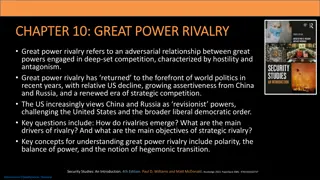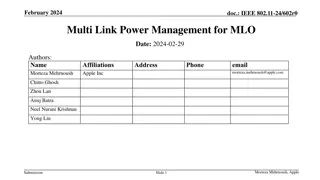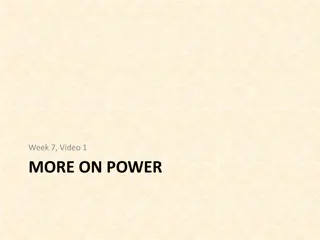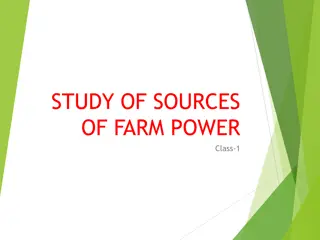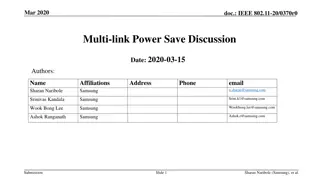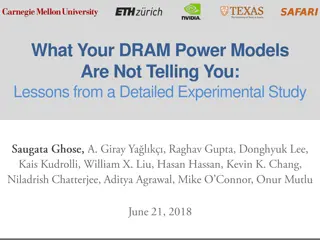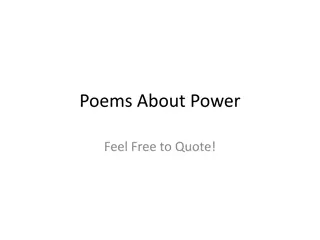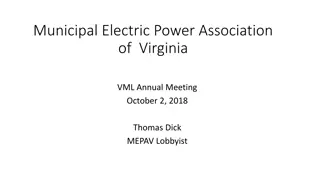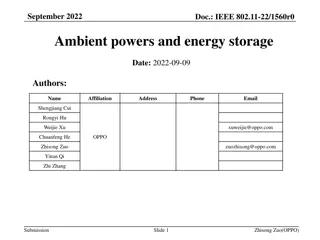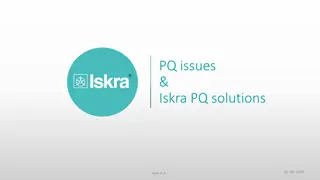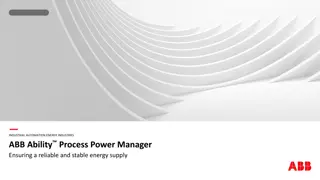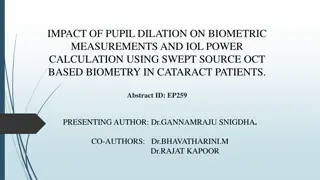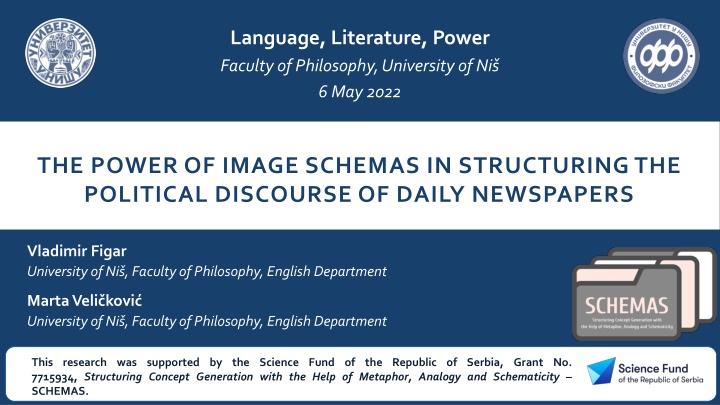
Power of Image Schemas in Political Discourse
"Explore the dynamic nature of image schemas in structuring political discourse through a research study supported by the Science Fund of Serbia. Learn about theoretical frameworks, aims, and the impact of image schemas on daily newspapers' content."
Download Presentation

Please find below an Image/Link to download the presentation.
The content on the website is provided AS IS for your information and personal use only. It may not be sold, licensed, or shared on other websites without obtaining consent from the author. If you encounter any issues during the download, it is possible that the publisher has removed the file from their server.
You are allowed to download the files provided on this website for personal or commercial use, subject to the condition that they are used lawfully. All files are the property of their respective owners.
The content on the website is provided AS IS for your information and personal use only. It may not be sold, licensed, or shared on other websites without obtaining consent from the author.
E N D
Presentation Transcript
Language, Literature, Power Faculty of Philosophy, University of Ni 6 May2022 THE POWER OF IMAGE SCHEMAS IN STRUCTURING THE POLITICAL DISCOURSE OF DAILY NEWSPAPERS Vladimir Figar University of Ni , Faculty of Philosophy, English Department Marta Veli kovi University of Ni , Faculty of Philosophy, English Department This research was supported by the Science Fund of the Republic of Serbia, Grant No. 7715934, Structuring Concept Generation with the Help of Metaphor, Analogy and Schematicity SCHEMAS.
PRESENTATION OUTLINE Theoretical framework Aims and research questions Image schemata identification protocol (SCHEMAS Group 2022) Cluster identification Corpus analysis Discussion Conclusions and future research
1. THEORETICAL FRAMEWORK Based on the previous research on image schemas (e.g., Johnson 1987; Lakoff 1987; Mandler 1992; Oakley 2007; Cienki 1997; Dewel 2005; Clausner and Croft 1999, etc.). Image schemas represent a a recurrent pattern, shape, and regularity in, or of, [the] ongoing ordering activities [and] it is important to recognize the dynamic character of image schemata (Johnson 1987: 29). Stem from our embodied experience and are typically based on spatial relations (Oakley 2007). Image schemas pose as highly dynamic structures (e.g., Johnson 1987; Dewel 2005; Clausner and Croft 1999; Cienki 1997). Clausner and Croft (1999: 4) argue that image schemata can be understood as a subtype of domains (in the sense of Langacker 1987), which they refer to as image schematic domains. Viewing schemas as domains marks a shift from non-propositional to PROPOSITIONAL structures, which affords their identification in discourse.
1. THEORETICAL FRAMEWORK Image schemas are basic abstract structures that recur in our construals of the world, and appear to play a fundamental role in various cognitive semantic processes (Clausner and Croft 1999: 4). Image schemas can also appear in clusters (e.g., Cienki 1997; Clausner and Croft 1999), i.e., groups of topically related elements in discourse. The potential of image schemas to appear in groups (or clusters) is licensed by the equivalent tendency identified in domains; namely, domains can form complexes, i.e., domain matrices (Langacker 1987; Clausner and Croft 1999). Image schema inventory (Johnson 1987: 126) CONTAINER BALANCE COMPULSION BLOCKAGE COUNTERFORCE RESTRAINT REMOVAL ENABLEMENT ATTRACTION MASS-COUNT PATH LINK FULL-EMPTY MATCHING SUPERIMPOSITION ITERATION CONTACT PROCESS SURFACE OBJECT COLLECTION CENTER-PERIPHERY CYCLE NEAR-FAR SCALE PART-WHOLE MERGING SPLITTING
2. AIMS AND RESEARCH QUESTIONS The mains aims of the present research are: i. To provide a reliable procedure for image schema identification in discourse, and ii. To explore the power of such schemas in structuring the political discourse of daily newspapers. Accordingly, the main research questions include the following: I. Did the Image Schemata Identification Protocol (SCHEMAS Group 2022) yield a satisfactory level of reliability? II. Which individual image schemas proved to be the most frequent in the given corpus sample? III. Did the identified image schemas exhibit any clustering tendencies, and if so, which were the most frequent combinations of schemas in the identified clusters? IV. What are some of the possible functions of the identified image schemas in the discourse of daily newspapers in the given corpus sample?
3. IMAGE SCHEMATA IDENTIFICATION PROTOCOL (SCHEMAS GROUP 2022) The Image Schemata Identification Protocol was motivated by the need for methodological consistency, similar to that outlined in MIPVU (Steen et al. 2010), Pragglejaz Group (2007), and Steen (2007). What is pertinent for the purposes of the image schemata identification protocol is their connection to domains proposed by Clausner and Croft (1999). This brings them from the non-propositional to the propositional level, and, in effect, they can be identified in discourse with a fair degree of certainty, via words or phrases related to specific image schematic domains. The Image Schemata Identification Protocol presented here will be focused on each of the main groups of image schemata separately, since each group exhibits certain idiosyncratic traits and entailments that can facilitate their identification in discourse.
3. IMAGE SCHEMATA IDENTIFICATION PROTOCOL (SCHEMAS GROUP 2022) Unlike the MIPVU, which essentially tests only the distinction between the metaphorical and literal uses of words, the present protocol will need to enable the researcher to discriminate between multiple groups of image schemata. In effect, it will contain a separate sub-protocol for each group, which will include the following main schemata: CONTAINMENT, FORCE, BALANCE, and PATH. Steps in the protocol and in each of the sub-protocols are based on the previous research on image schemas (e.g., Johnson 1987; Lakoff 1987; Cienki 1997; Clausner and Croft 1999; Dewel 2005). Part of the protocol for identifying words (or phrases) related to the FORCE schemas in discourse is given in the table below.
Selected section from the Protocol for identifying words (or phrases) related to FORCE schemas in discourse FORCE IN GENERAL: Determine whether the target word (or phrase) describes any interaction that involves the influence of force(s) between objects or participants. To do so, rely on the following steps: I. a) determine whether the target word (or phrase) can be used to identify the origin of the forceful interaction, and whether the force in question might be stemming from a particular object or participant in the situation; b) determine whether the target word (or phrase) reveals a causal sequence of events triggered by force; c) determine whether the target word (or phrase) can be associated with directed influences of forces, as force has a vector quality, [i.e.,] a directionality (Johnson 1987: 43). In addition, object or participants can either change their positions as a result of such forces (i.e., they can move), or remain in the same position; d) determine whether the target word (or phrase) describes an object (or participant) as moving along a clearly defined path, as a result of the impact of force, or it refers to a less prototypical scenario. For instance, with explosion the force moves off in all directions creating a potentially infinite number of paths (Johnson 1987: 43). The only way to identify a single path is to focus on the movement of an object affected by the explosion (Johnson 1987); e) determine whether the target word (or phrase) reveals force as a gradable phenomenon. COMPULSION: determine whether the target word (or phrase) reveals the exertion of an outside force onto an object or participant. II. BLOCKAGE: determine whether the target word (or phrase) shows the presence of a certain obstacle that might obstruct the effects of force that the agent is exerting. III. COUNTERFORCE: determine whether the target word (or phrase) reveals direct interaction between forces, reflected in the direct interaction between objects or participants. IV. REMOVAL OF RESTRAINT: determine whether the target word (or phrase) signals the presence of an object, participant, or other entity that can obstruct the agent s motion along a path, and a subsequently exerted force used to remove such an obstacle. V.
4. CLUSTER IDENTIFICATION Cluster identification was conducted following the main guidelines from previous research dealing with metaphor clusters (e.g., Corts and Polio 1999; Corts 2006; Corts and Meyers 2002; Kimmel 2010; Koller 2003, 2008; Cameron and Low 2004; Cameron and Stelma 2004; Cameron 2003, 2007; Figar and Antovi 2015; Figar 2019, 2021; etc.). A metaphor cluster represents a group of topically related metaphorical expressions found in ongoing discourse (Figar 2019: 235), and it includes at least three metaphorical expressions. Likewise, an image schema cluster consists of a group of topically related image schemas found in ongoing discourse, and it also includes at least three words (or phrases) related to specific image schemas. Following the procedures outlined in Koller (2003), Figar and Antovi (2015), and Figar (2019; 2021), after the identification of individual schemas, we i. used the dispersion plots from WordSmith Tools 6.0(Scott 2010, 2014; Tribble 2010), and based on the numbered positions of the tagged items identified potential cluster candidates; ii. conducted a qualitative analysis of each cluster candidate to ascertain that all items were indeed topically related; iii. analyzed cluster structure and identified the most dominant schema in each of the clusters (i.e., the schema with the highest frequency in the cluster.
DISPERSION PLOTS CLUSTER CANDIDATES NUMBERED POSITIONS OF TAGGED ITEMS CONCORDANCE
5. CORPUS ANALYSIS Corpus sample 3 articles (in English): U.K. vs. Oligarchs: The Gloves Are Now Off , The New York Times, 13 March 2022, How Ukraine has become the crucible of the new world order, The Guardian, 12 March 2022, Covid inquiry s public hearings will not begin until 2023, making final report before election unlikely, The Guardian, 11 March 2022. Total: 3,825 words, 698 hits, 182.48 hits per 1,000 words. Procedure: i. reading the entire article for comprehension; ii. identifying words or phrases potentially linked to specific image schemas; and iii. evaluating such words or phrases against the Image Schemata Identification Protocol (SCHEMAS Group 2022).
5. CORPUS ANALYSIS All manually for specific image schemas and quantitative WordSmith Tools 6.0 (Scott 2010, 2014; Tribble 2010). The values of interest were normalized counts per 1,000 words, rather than the number of occurrences. Dispersion plots facilitate the identification of sections with increased schema density, i.e., potential clusters. articles were tagged prepared analysis for using
5.1 PROTOCOL RELIABILITY 6 raters participated in this part of the study. All raters were familiarized with the Protocol and the theoretical background. Analyses conducted passes, with 15 days between the passes. Final discussion between raters. Reliability assessment - Fleiss Kappa and Cochran s Q (in line with MIPVU, Steen et al. 2010). Schema / not schema agreement (before discussion) Article Fleiss Kappa (k) Sig. 95% CI Lower Bound Upper Bound New York Times .700 <.0005 .699 .701 in two Guardian 1 .726 <.0005 .725 .727 Guardian 2 .721 <.0005 .719 .722 Average .716 (good)
Specific qualitative classification of schemas agreement (before discussion), Cochrans Q Article Cochran s Q Sig. N df New York Times 56.98 <.0005 145 5 This suggests that the difference between the lowest scoring analyst, who identified 109 lexical units as related to specific image schemas, and the highest scoring analysts, who identified 131 lexical units as related to specific image schemas, is too great to be due to chance variation between analysts. In other words, part of the variation between analysts in schema identification in the reliability test is due to analyst bias. Similar results have been reported in Steen et al. (2010). Article Cochran s Q Sig. N df Guardian 1 145.32 <.0005 184 5 This suggests that the difference between the lowest scoring analyst, who identified 127 lexical units as related to specific image schemas, and the highest scoring analysts, who identified 184 lexical units as related to specific image schemas, is too great to be due to chance variation between analysts. In other words, part of the variation between analysts in schema identification in the reliability test is due to analyst bias. Similar results have been reported in Steen et al. (2010). Article Cochran s Q Sig. N df Guardian 2 58.08 <.0005 83 5 This suggests that the difference between the lowest scoring analyst, who identified 44 lexical units as related to specific image schemas, and the highest scoring analysts, who identified 77 lexical units as related to specific image schemas, is too great to be due to chance variation between analysts. In other words, part of the variation between analysts in schema identification in the reliability test is due to analyst bias. Similar results have been reported in Steen et al. (2010). All of the initial disagreements between the 6 raters were resolved in the final discussion (following the methodological procedure outlined in Steen et al. (2010), and Pragglejaz Group (2007)).
5.2 INDIVIDUAL IMAGE SCHEMAS Quantitative analysis showed the highest frequencies and densities of FORCE, PATH, and CONTAINMENT schemas. Repeated measures ANOVA did not reveal significant differences in the overall mean densities between the three most frequent groups of image schemas (PATH- FORCE, p=.97; PATH-CONT., p=.10; FORCE-CONT., p=.17). 50 45 40 35 30 25 20 15 10 5 0
5.3 IMAGE SCHEMA CLUSTERS CLUSTER SIZE The 18 most frequent were 16 clusters containing 5 schemas, 14 followed by 3, 4, and 6-schema 12 10 clusters, respectively. 8 Largest clusters showed much 6 lower frequencies. 4 2 0
5.4 IMAGE SCHEMA CLUSTERS DOMINANT SCHEMA 35 FORCE schema proved to be 30 dominant in the largest number 25 20 of clusters, followed by PATH 15 10 schemas, equal counts of PATH 5 and FORCE schemas, and 0 CONTAINMENT schemas, respectively.
5.5 POSSIBLE ROLES OF IMAGE SCHEMAS IN DISCOURSE CONTAINMENT schema(s) (background, cohesive function; static relations; sometimes linked to motion and force) FORCE schema(s) (dynamic exchange and interaction; often linked to motion) PATH schema(s) (motion, position, links between elements, scaling; often linked to force)
5.6 POSSIBLE ROLES OF IMAGE SCHEMAS IN DISCOURSE - EXAMPLES Cluster with the dominant PATH schema. CONTAINMENT schemas describe the two locations. PATH schemas describe motion and progression (i.e., active, dynamic processes). FORCE schemas exhibit direct interaction with PATH schemas, and also describe active, dynamic processes. has finally led - motion under the influence of force. curbing the flood (counter)force against the already initiated motion. The use of specific schemas imposes a particular viewpoint, thereby exhibiting a force-dynamic effect on the readers (in the sense of Oakley 2005). Russia s war in<s-containment> Ukraine has finally led<s-path><s-force> the British government to go after<s-path> ultrawealthy Russians in<s- containment> London. But curbing the flood<s- path><s-counterforce> of corrupt money will require - the effects of going after<s-path> more than the big names. The New York Times
5.6 POSSIBLE ROLES OF IMAGE SCHEMAS IN DISCOURSE - EXAMPLES Cluster with the dominant FORCE schema. All schemas express highly dynamic interactions. Interaction between FORCE and PATH schemas. The use of specific words and phrases related to particular image schemas again exhibits a force-dynamic effect (Oakley 2005), and enforces a very specific viewpoint (or specific framing in the sense of Fillmore 1982). It [Putin s threat] has undoubtedly inhibited<s- force><s-blockage> the US and British response<s-force><s-counterforce>, with fears expressed about a third world war . A dangerous precedent has been set<s-force><s- path>. The Guardian
5.7 POSSIBLE ROLES OF IMAGE SCHEMAS IN DISCOURSE - SUMMARY The use of specific words or phrases related to particular image schemas can impose a force-dynamic effect on the readers (in the sense of Oakley 2005). Namely, specific schemas can impose a particular perspective, i.e., a particular viewpoint, or particular framing of events similar to the notion of evoked frames in the sense of Fillmore (1982). The proposed persuasive function can be facilitated by provoking an emotional response (e.g., Mio 1997; Charteris-Black 2004; etc.). For instance, changing the vocabulary related to FORCE schemas with more neutral vocabulary would arguably tone down the rhetorical effect of the text. However, all of these assumptions require additional experimental validation.
6. DISCUSSION i. Did the Image Schemata Identification Protocol (SCHEMAS Group 2022) yield a satisfactory level of reliability? The Image Schemata Identification Protocol showed a satisfactory degree of reliability, and all discrepancies between the 6 analysts were successfully resolved after the general discussion. ii. Which individual image schemas proved to be the most frequent in the given corpus sample? Quantitative corpus analysis showed the highest frequencies and densities of FORCE, PATH, and CONTAINMENT schemas, respectively. iii. Did the identified image schemas exhibit any clustering tendencies, and if so, which were the most frequent combinations of schemas in the identified clusters? Corpus analysis also revealed a marked clustering tendency. FORCE schemas proved to be the most dominant (showing the highest number of occurrences in most clusters), followed by PATH schemas, equal counts of PATH and FORCE schemas, and CONTAINMENT schemas.
6. DISCUSSION iv. What are some of the possible functions of the identified image schemas in the discourse of daily newspapers in the given corpus sample? CONTAINMENT schemas seem to have a predominantly cohesive function, providing the background for the main interactions. PATH schemas were associated with more dynamic events, typically signaling motion, position, and scaling (or grading). They often interacted with FORCE schemas. FORCE schemas were associated with highly dynamic interactions and exchanges, and often interacted with PATH schemas. This was especially evident in the identified clusters. Specific words or phrases related to particular image schemas can impose a force-dynamic effect on the readers (in the sense of Oakley 2005). The possible rhetorical effects triggered by particular image schemas and their clusters should undergo experimental validation.
7. CONCLUSIONS AND FUTURE RESEARCH The Image Schemata Identification Protocol presents itself as a reliable tool for the identification of words and phrases related to specific image schemas in discourse. Application of the protocol should ensure the convergent validity of findings from the future studies in the filed. Image schemas identified in the given corpus sample showed high frequencies and densities, and also exhibited a marked clustering tendency. This contributes to the idea of the dynamic nature of meaning construction and schema interaction in discourse. The investigation should be expanded to other corpora. The proposed functions of image schemas in the political discourse of daily newspapers should be further explored in experimental setups (e.g., reaction time studies, eye tracking studies, etc.).
Thank you for your attention! Questions?
REFERENCES Cienki, A. (1997). Some Properties and Groupings of Image Schemas. In M. Verspoor, K. D. Lee, and E. Sweetser (Eds.), Lexical and syntactical constructions and the construction of meaning (pp. 3 15). Amsterdam: John Benjamins. Clausner T.C. and Croft W. (1999). Domains and image schemas. Cognitive Linguistics, 10(1), 1 31. Croft, W. and Cruse, A.D. (2004). Cognitive Linguistics. Cambridge: Cambridge University Press. Dewel, R. (2005). Dynamic patterns of CONTAINMENT. In B. Hampe and J. Grady (Eds.), From Perception to Meaning. Image Schemas in Cognitive Linguistics (pp. 369 394). Berlin and New York: Mouton de Gruyter. Evans, V. and Green, M. (2006). Cognitive Linguistics: An Introduction. Edinburgh: Edinburgh University Press. Johnson, M. (1987). The Body in the Mind: The Bodily Basis of Meaning, Imagination, and Reason. Chicago and London: The University of Chicago Press. Lakoff, G. (1987). Women, Fire, and Dangerous Things: What Categories Reveal about the Mind. Chicago and London: The University of Chicago Press. Lakoff. G. (1990). The Invariance Hypothesis: Is abstract reason based on image schemas? Cognitive Linguistics, 1(1), 39 74.
REFERENCES Lakoff, G. and Turner, M. (1989). More than cool reason: The power of poetic metaphor. Berkeley: University of California, Berkeley. Lakoff, G. and Johnson, M. (2003[1980]). Metaphors We Live By. London: The University of Chicago Press. Langacker, R. W. (1987). Foundations of Cognitive Grammar. Volume 1. Theoretical Prerequisites. Stanford: Stanford University Press. Mandler, J. (1992). How to Build a Baby: II. Conceptual Primitives. Psychological Review, 99(4), 587 604. Mandler, J. (2012). On the Spatial Foundations of the Conceptual System and Its Enrichment. Cognitive Science, 36(3), 421 451. Oakley, T. (2007). Image Schemas. In D. Geeraerts and H. Cyckens (Eds.), The Oxford Handbook of Cognitive Linguistics (pp. 214 235). Oxford: Oxford University Press. Pragglejaz Group (2007). MIP: A Method for Identifying Metaphorically Used Words in Discourse. Metaphor and Symbol, 22(1), 1 39. Steen, G. J. (2007). Finding Metaphor in Grammar and Usage. Amsterdam and Philadelphia: John Benjamins Publishing Company. Steen, G. J., Dorts, A. G., Herrmann, J. B., Kaal, A. A., Krennmayr, T., and Pasma, T. (2010). A Method for Linguistic Metaphor Identification: From MIP to MIPVU. Amsterdam and Philadelphia: John Benjamins Publishing Company.



